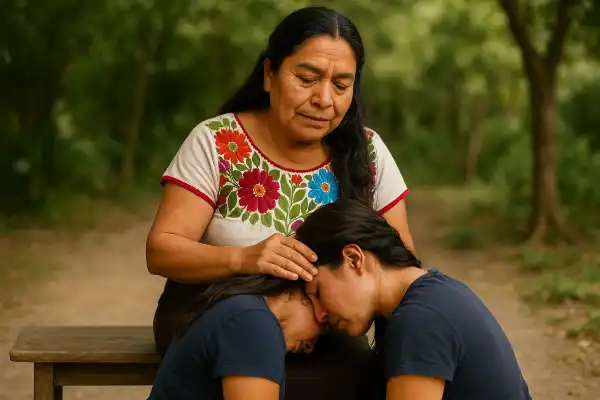Who is a curandera in our modern world, where traditional healing practices often seem distant from daily life? Many people find themselves drawn to these ancient ways of healing, sensing there might be wisdom in practices that have sustained communities for generations. The question arises from a deep longing to understand how these sacred healers bridge the gap between physical ailments and spiritual well-being.
María del Pilar Fernández has witnessed this curiosity grow stronger as people seek more holistic approaches to health. Drawing from her lineage of curanderas in Oaxaca and her studies in cultural anthropology, she believes that understanding what a curandera does reveals pathways to healing that honor both ancient wisdom and contemporary needs.
Who is a curandera?
A curandera is a traditional healer who practices curanderismo, a holistic healing system that addresses the body, mind, and spirit through various therapeutic modalities including herbal medicine, spiritual cleansing, energy work, and sacred counseling. Curanderismo emerged over 500 years ago from the intersection of Indigenous, Spanish, West African, Arab, and Asian healing traditions in Mexico, creating a comprehensive approach to wellness that views illness as an imbalance requiring restoration of harmony.
The practice of a curandera extends far beyond treating physical symptoms. These healers believe that God or a higher power grants them divine knowledge and skills to practice healing, and they serve as bridges between the earthly and spiritual realms. Rather than replacing conventional medical treatment, curanderas often work alongside healthcare providers, addressing cultural needs and treating the whole person through a multidisciplinary approach that encompasses relationships and spirit.

Specialized healing practices
Curanderas develop expertise in various specialized areas, each addressing different aspects of human wellness. Yerberas specialize in herbal medicine, using roots, leaves, and plant-based remedies to treat conditions like diabetes, heart problems, and digestive disorders. Sobadoras practice traditional bodywork, using Indigenous-based massage techniques similar to acupressure to treat blockages in the digestive tract, constipation, and areas of pain or discomfort, while also helping release emotional, spiritual, mental, and physical wounds stored in the cellular body.
Hueseros serve as traditional bone-setters, trained in Indigenous methods of adjusting bones and performing spinal alignments. Parteras fulfill the sacred role of midwife, attending births and supporting women through pregnancy, labor, delivery, and postpartum recovery. Some curanderas work as consejeros, providing spiritual consultation, while limpiadores conduct ritual cleansings, and espiritualistas focus on faith healing and soul work.
Spiritual cleansing and energy healing
Central to curandera practice are limpias, spiritual cleansings designed to remove negative energy and restore energetic balance. These purification rituals use prayer and sacred tools such as feathers, fresh raw eggs, or consecrated herbal bundles to remove stagnant energy from a person’s luminous body. During an egg limpia, the curandera uses a raw egg in its shell to ritually cleanse and extract energy from the auric field, then breaks the egg into water to “read” the person’s energetic state.
Barridas involve sweeping the body with bundles of herbs like rosemary, rue, basil, and peppertree branches, often accompanied by sprinkling consecrated floral waters on the client. For deeper purification, curanderas burn sage, cedar, juniper, or copal resin to create cleansing smoke, and may incorporate naturally fertilized eggs, salt, cornmeal, water, and soil into their ceremonies.
Herbal medicine and plant healing
Curanderas possess vast knowledge of medicinal plants and herbs passed down through generations, using remedies like chamomile tea for relaxation, aloe vera for skin ailments, sage, and rue, each believed to have specific healing properties. Common medicinal plants in curandera practice include romero (rosemary), ruda (rue), albahaca (basil), sabila (aloe vera), and yerbabuena (mint), used for various healing purposes and spiritual protection.
Plant gathering is considered as fundamental to curanderismo as prayer itself, with curanderas offering thanks to the land and plants every time they collect medicine, teaching that all life is sacred. The preparation of these remedies follows traditional methods, creating teas, tinctures, salves, and ointments that address both physical ailments and energetic imbalances.
Sacred counseling and emotional healing
Pláticas, or heart-to-heart talks, form the foundation of curandera practice, providing clients the opportunity to speak openly and honestly about their circumstances in a confidential, non-judgmental environment. The term conveys deep trust and respect, as curanderas view their relationship with clients as sacred responsibility.
Through this spiritual counseling, curanderas help clients address conditions like susto (soul loss or soul wound), which can result from accidents, severe trauma, or unresolved grief. Many curanderas believe they must first heal their own susto, or “dark night of the soul,” before they can effectively heal others, giving them the depth of understanding needed to guide clients through similar experiences.
Integration with modern healthcare
Contemporary curanderas often work within integrative healthcare models. Experienced curanderas encourage thoughtful inclusion of traditional Indigenous healing practices alongside conventional medical treatments, seeking to educate healthcare providers about Mexican Indigenous healing ways so they can better serve their patients’ cultural needs. Professional curanderas refer clients to physicians and other healthcare providers when necessary, never advising clients to avoid medical treatment in favor of curanderismo alone.
Research indicates that traditional healing practices among Mexican and Mexican Americans may be utilized by 50-75% of individuals in some parts of the United States. This widespread use reflects the cultural significance and effectiveness many people experience through curandera healing, particularly for addressing spiritual and emotional aspects of illness that conventional medicine may not fully address.
Disclaimer
Please note that Maria is not a physician, psychologist, or nurse. These culture-specific spiritual healing services are not meant to replace medical or psychological diagnosis and treatment. It is recommended that you see a licensed physician or licensed health care professional for any physical or psychological ailment you may have.
Last summer, María received a visit from Catalina, a young mother from her village who had been struggling with persistent headaches and difficulty sleeping since her husband’s deployment. Catalina had visited doctors who could find no physical cause for her symptoms. During their plática, María recognized the signs of susto – a spiritual condition where trauma causes part of the soul to become disconnected. She prepared a gentle limpia using fresh basil and rosemary, speaking prayers of protection while sweeping away the heavy energy that had settled around Catalina’s heart. Following the cleansing, María brewed a tea of manzanilla and hierba buena, teaching Catalina how to prepare it each evening. She also recommended that Catalina continue working with her physician while incorporating these traditional remedies. Over the following weeks, Catalina’s sleep gradually improved, and the headaches became less frequent. When her husband returned safely, she credited both her doctor’s care and María’s healing wisdom for helping her navigate that difficult time with greater strength and peace.
